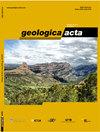摩洛哥早奥陶世费祖阿塔生物群中大量出现的浮游树枝状爬行动物合叶虫(Calyxdendrum)
IF 1.3
4区 地球科学
Q2 GEOLOGY
引用次数: 0
摘要
本文对 Calyxdendrum 属进行了修订,以包括奥陶纪(Tremadocian 至 Sandbian)的浮游树枝状爬行动物。费祖阿塔生物群中大量出现的 Calyxdendrum amicabilis n. sp.是迄今为止发现的为数不多的树枝状形态的合叶体之一。该物种由四到六个细长的锥形管胞组成的复合结构呈伞状合叶体。在这些管胞中,单个的管胞通过其短内膜连接在一起,形成一个形状不规则的下部膜。该物种发现于摩洛哥扎戈拉以北特尔纳塔平原 Bou Izargane 地段的晚 Tremadocian Sagenograptus murrayi 生物区。根据解释,这种大量出现的现象代表了浮游石斛群被低速水流搬运或在宽阔的浅海陆架地区主动移动到不同的水域。它们在 "汤状 "软沉积物中定居,随后被压实在现已碎化的泥岩中。迄今为止,人们只知道萼片石斛属浮游石斛分布在近刚瓦纳地区,但当人们对其有更深入的了解时,可能会发现其生物地理分布更广。本文章由计算机程序翻译,如有差异,请以英文原文为准。
Mass occurrence of planktic dendroid graptolite synrhabdosomes (Calyxdendrum) from the Early Ordovician Fezouata biota of Morocco
The genus Calyxdendrum is here revised to include planktic dendroid graptolites from the Ordovician (Tremadocian to Sandbian). The mass occurrence of Calyxdendrum amicabilis n. sp. from the Fezouata biota represents one of the few occurrences of synrhabdosomes of dendroid morphology that have ever been discovered. Composite structures, formed from about four to six slender, conical tubaria of the species appear as umbrella-shaped synrhabdosomes. In these, the individual tubaria are connected by their short nemata forming an irregularly shaped proximal membrane. The species is found in the late Tremadocian Sagenograptus murrayi Biozone of the Bou Izargane section in the Ternata plain north of Zagora, Morocco. The mass occurrence is interpreted to represent planktic dendroid colonies transported by low velocity currents or moving actively into different water regions on a wide shallow shelf region. They settled in the “soupy” soft sediment, where they were subsequently compacted in the now lithified mudstone. Planktic dendroids of the genus Calyxdendrum are so far known exclusively from the peri-Gondwana region, but may prove to show a wider biogeographical distribution when better known.
求助全文
通过发布文献求助,成功后即可免费获取论文全文。
去求助
来源期刊

Geologica Acta
地学-地质学
CiteScore
2.50
自引率
6.70%
发文量
13
审稿时长
>12 weeks
期刊介绍:
- Relevant conceptual developments in any area of the Earth Sciences.
- Studies presenting regional synthesis.
- Thematic issues or monographic volumes presenting the results from one or more research groups.
- Short papers reflecting interesting results or works in progress.
- Contributions and results from Research Projects, Workshops, Symposiums, Congresses and any relevant scientific activity related to Earth Sciences.
- Geologica Acta aims to stimulate rapid diffusion of results and efficient exchange of ideas between the widespread communities of Earth Science researchers (with special emphasis on Latinamerica, the Caribbean, Europe, the Mediterranean
 求助内容:
求助内容: 应助结果提醒方式:
应助结果提醒方式:


